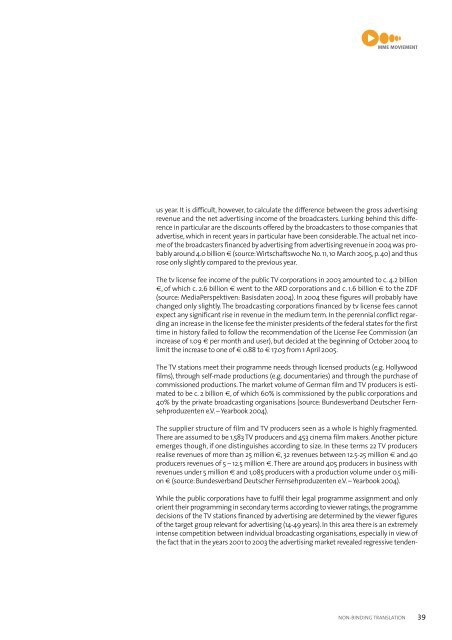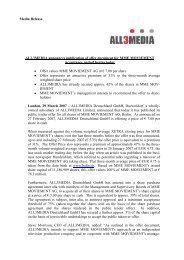Drucken GB - MME moviement
Drucken GB - MME moviement
Drucken GB - MME moviement
You also want an ePaper? Increase the reach of your titles
YUMPU automatically turns print PDFs into web optimized ePapers that Google loves.
us year. It is difficult, however, to calculate the difference between the gross advertising<br />
revenue and the net advertising income of the broadcasters. Lurking behind this difference<br />
in particular are the discounts offered by the broadcasters to those companies that<br />
advertise, which in recent years in particular have been considerable. The actual net income<br />
of the broadcasters financed by advertising from advertising revenue in 2004 was probably<br />
around 4.0 billion € (source:Wirtschaftswoche No. 11,10 March 2005,p. 40) and thus<br />
rose only slightly compared to the previous year.<br />
The tv license fee income of the public TV corporations in 2003 amounted to c. 4.2 billion<br />
€, of which c. 2.6 billion € went to the ARD corporations and c. 1.6 billion € to the ZDF<br />
(source: MediaPerspektiven: Basisdaten 2004). In 2004 these figures will probably have<br />
changed only slightly. The broadcasting corporations financed by tv license fees cannot<br />
expect any significant rise in revenue in the medium term. In the perennial conflict regarding<br />
an increase in the license fee the minister presidents of the federal states for the first<br />
time in history failed to follow the recommendation of the License Fee Commission (an<br />
increase of 1.09 € per month and user), but decided at the beginning of October 2004 to<br />
limit the increase to one of € 0.88 to € 17.03 from 1 April 2005.<br />
The TV stations meet their programme needs through licensed products (e.g. Hollywood<br />
films), through self-made productions (e.g. documentaries) and through the purchase of<br />
commissioned productions. The market volume of German film and TV producers is estimated<br />
to be c. 2 billion €, of which 60% is commissioned by the public corporations and<br />
40% by the private broadcasting organisations (source: Bundesverband Deutscher Fernsehproduzenten<br />
e.V. – Yearbook 2004).<br />
The supplier structure of film and TV producers seen as a whole is highly fragmented.<br />
There are assumed to be 1,583 TV producers and 453 cinema film makers. Another picture<br />
emerges though, if one distinguishes according to size. In these terms 22 TV producers<br />
realise revenues of more than 25 million €, 32 revenues between 12.5-25 million € and 40<br />
producers revenues of 5 – 12.5 million €. There are around 405 producers in business with<br />
revenues under 5 million € and 1,085 producers with a production volume under 0.5 million<br />
€ (source: Bundesverband Deutscher Fernsehproduzenten e.V. – Yearbook 2004).<br />
While the public corporations have to fulfil their legal programme assignment and only<br />
orient their programming in secondary terms according to viewer ratings, the programme<br />
decisions of the TV stations financed by advertising are determined by the viewer figures<br />
of the target group relevant for advertising (14-49 years). In this area there is an extremely<br />
intense competition between individual broadcasting organisations, especially in view of<br />
the fact that in the years 2001 to 2003 the advertising market revealed regressive tenden-<br />
NON-BINDING TRANSLATION<br />
39




